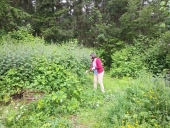





thanks Leonora! great to hear you have seen some of the videos! the internet is such a remarkable tool for us to be able to connect and share and inspire other producers and makers- I think it is truly when the internet gets to be its "best self" I certainly found some small joy coming through the pandemic how it allowed so many of us to be online learning and still sharing with each other and realized the time was right to use that capacity for forging a stronger alliance and lift skills for many of us in this part of the world who can build up a network. its amazing to see this happening all over the world as we rethink our supply chains.Inge Leonora-den Ouden wrote:Hi Sharon. I don't live close by (but in the Netherlands, at the other side of the Atlantic Ocean), but I have seen several videos (youtube) in which you showed your work with plants and fibers. Thank you for the inspiration.


Jenny Wright wrote:
Sharon Kallis wrote:
PSA-fibre tip... Harvest for food and tea in an area different from where you might want to harvest for fibre later, pinched tips cause the plant to bifurcate with the lost leader, so fibre is inferior 😉
If i harvest at the very beginning of the spring, the shoots are only inches from the ground. Then I stop harvesting when they get higher and my nettles grow to a good 7-8' tall, long and straight with the branching only early on near the ground.
Does it really affect the fiber quality if I am doing it like that?
So far I've only eaten them and messed around with the fiber in small quantities (experimenting making short bits of twine with my kids) so I really don't have the background to tell if the fiber is good or not.



